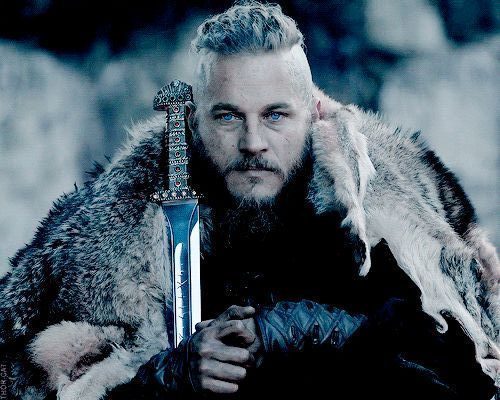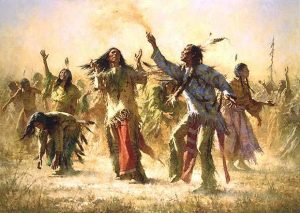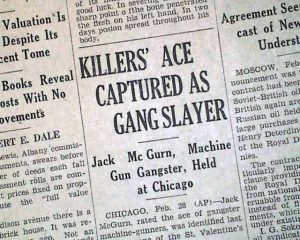For three hundred years, beginning in the ninth century, they sailed the known world and discovered lands beyond their maps.1 They pillaged the peoples of England and France, canals along Middle Eastern coasts, and even their own Scandinavia, venturing as far as the east coast of North America. Being given names, such as pirates, barbarians, monsters, and farmers, today we know them as Vikings. Their people did not fear death in combat, and they would go to great lengths to find a worthy way to die. Being killed heroically with a weapon in hand could get the attention of a Valkyrie, or angelic female warrior, to determine if ones death was worthy. If deemed worthy one would ascend to Valhalla, the Nordic afterlife for a warrior, where one would brag about one’s adventures and fight to the death daily in the army of Oden, chieftain of the Norse gods, as preparation for the end of the world. One man that stood out among these hardened people and became one of the first Scandinavian kings was Ragnar Lothbrok.2
Being born just before the turn of the year 800 CE, Ragnar Lothbrok brought together the Scandinavian war bands under his command. With Europe poorly protected, and with Charlemagne’s rule coming to an end, Ragnar took the advantage and led his Vikings on many campaigns to loot Europe of its treasures.3 With little real knowledge of the Norsemen, the peoplesand treasures of Europe were easy targets. When in the fighting line, Ragnar was said to dwarf his companions that stood around him and fought in his armies as a berserker.4 A berserker is a warrior that fights in a rage-filled trance, being able to take on multiple injuries before falling in battle. Ragnar was admired for his skills in battle and for his strategic mind. His armies could hold their own against Charlemagne’s forces due to his strategic cunning. Ragnar is even father to other well-known Viking warriors, Bijorn Ironside, Hubb, and Ivar the Boneless, a figure of terror in Irish and English storytelling.5

The untimely demise of Ragnar Lothbrok became a story of revenge. With so many battles and victories against the Anglo Saxons, Ragnar had created enemy in Aelle, ruler of York. During Ragnar’s last battle, he was captured by the Anglo Saxons and became a prisoner. In honor of his new prisoner, Aelle, ruler of York, ordered his men to build a pit of snakes for Ragnar to be thrown into. As the snake venom was running through Ragnar’s veins, he is reported to have uttered, as his last words, “How the little pigs will grunt when they hear how the old boar has died,” referring to his sons as the avengers of his death.6 The death of Ragnar Lothbrok supposedly triggered a new age of Viking attacks. Those attacks had the ferocity and intensity that Vikings later became known for. Seeking to avenge their father’s death, Ivar the Boneless and his two brothers led their Viking forces to East Anglia in 865 CE. In the name of revenge, the brothers captured Aelle and killed him with the rite of the blood eagle.7 This rite was a gruesome and painful form of execution by torture that resulted in a slow death; after the torture, the poor soul subjected to the rite was to be tied by the wrists in the air to two separate trees, to resemble a bird in flight, to honor Oden’s sacred bird, the eagle. The ritual was so gruesome that it was hardly ever used and only on those deserving of it.

The story of Ragnar Lothbrok became a legend and was written into the Icelandic sagas and the Gesta Danorum.8 Over time he became another epic hero in a story with impossible adventures. Between the seventh and ninth centuries, multiple stories and lives of other people named Ragnar have surfaced. Despite these multiple stories, there will only be a true original Ragnar Lothbrok, the one that forced his way into history and built the reputation of the Vikings.
- Gale Encyclopedia of World History, 2008, s.v. “Viking Raids and Norman Conquests (8th to 11th Centuries).” ↵
- P.D. Kirby, “Review of A.P. Smyth’s Scandinavian Kings in the British Isles 850-880,” The English Historical Review 94, no. 370 (January 1979): 162-163. ↵
- P.D. Kirby, “Review of A.P. Smyth’s Scandinavian Kings in the British Isles 850-880,” The English Historical Review 94, no. 370 (January 1979): 162-163. ↵
- Gale Encyclopedia of World History, 2008, s.v. “Viking Raids and Norman Conquests (8th to 11th Centuries).” ↵
- Encyclopedia of the Barbarian World, 2004, s.v. “Bronze Age to Early Middle Ages,” by Peter Bogucki and Pam J. Crabtree. ↵
- Encyclopedia of the Barbarian World, 2004, s.v. “Bronze Age to Early Middle Ages,” by Peter Bogucki and Pam J. Crabtree. ↵
- Roberta Frank, “Viking Atrocity and Skaldic Verse: The Rite of the Blood Eagle.” The English Historical Review 99, no. 391 (April 1984):332-343. ↵
- Neil Schlager and Josh Lauer, Science and Its Times (Detroit: Gale, 2001), 100-101. ↵



50 comments
Brittney Carden
Vikings is one of my absolute favorite TV series, and I’m so thrilled that someone wrote an article about the famous Ragnar Lothbrok. He was one of the first of the Scandinavian people to have a real passion for expedition and adventure to new lands. I loved Rangar in the show, I think he is portrayed as a fearsome leader that just wanted what was best for his people. The culture and religion of the Norsemen is one that I’m extremely fascinated by, I’ve always dreamed of going there to study the rich history.
Elliot Avigael
Vikings is one of my favorite TV shows, so you can imagine my excitement when I saw that somebody had written an article on truly one of the greatest vikings that ever lived, Ragnar Lothbrok! Ragnar was definitely not the first viking of his time, (and wouldn’t be the last), but it was his ambitions of discovering new lands and reputation as a great warrior that earned him his legendary status on the Mount Rushmore of Vikings.
While it’s a shame that such a fearsome warrior and ruler was denied Valhalla by King Aelle, it was his own death that set forward the golden age of the Vikings. It was him who built the foundation for his sons’ further incursions into Ireland and England, and whose sons would eventually conquer the latter. According to legend Ivar, perhaps the most ruthless of his sons, would go on to kill not one, but two English kings and unseat another.
Considering Ragnar has his own saga, I also encourage you to check out the sequel to this story, The Tale Of Ragnar’s Sons.
Carlos Serna
Today, Vikings are being popular with their tv shows and even videogames. I decided to learn about them and in this article, I learned about one of the most recognize Vikings that ever have live, Ragnar Lothbrok. I think that it was a shame that he dies as a prisoner and not in combat with honor as he would it like it.
Madeline Emke
I have never seen the show Vikings, so I found this article very informative and interesting to read. I had never heard of Ragnor Lothbrok nor the gruesome revenge his sons reaped against his killers. It was informative to hear about the beliefs of the Vikings before discussing one of the more legendary figures in Viking history but I was left curious about the mythology of Valhalla and a warriors’ death than the very brief section discussing Ragnor Lothbrok.
Nelly Perez
Viking stories are so interesting to learn about. They had a type of religion even though it really was not seen as one because they believed in a heaven, only by a different name. I did not know that the word Valkyrie had a meaning. I only heard the name in a movie and a TV show, but I did not know the name had a meaning. Vikings were portrayed differently than the media had presented them, but this article shows the historical side.
Jeremiah Durand
Wow interesting read. I truly enjoy watching vikings series or interpretations of this story on Netflix and HBO but never really knew where the stories got their basis from. Ragnar is referenced in many of these shows and now understanding the story behind the name, reveals a better understanding of the characters as well. It is unfortunate he died in such a weird and crazy way, would have loved to have him turn out to die in some heroic way.
Felipe Macias
Vikings were the dominant force of the Northern Hemisphere, with no surprise of their capabilities. Viking genes are still present today, with remarkable people as Hafþór Júlíus Björnsson, the strongman who played The Mountain. In no other place are these mighty men seen, as they brought back the best women from the lands they pillaged to their homelands of Sweden, Finland, and Norway.
Michael Hinojosa
I always thought of the vikings as mindless savages, as thats what the media always presented them as, so you could imagine my surprise when I read this article and found out that Ragnar was intelligent enough to outsmart europeans while also having the physical strength to match! I will also have to look into more of his stories as they do sound extremely interesting, especially given how amazing the main character is!
Nathan Hartley
I have never seen the show vikings, however the pictured looked familiar so I read the article. I thought it was cool that Ragnar was able to outsmart so many people in combat and that he is a legend because of it. I also like that his sons were able to get revenge for him in the end.
Valeria Perez
I have heard about the TV show Vikings and I became interested in the article because I recognized the picture. Learning about Ragnar’s story is very interesting! More than just physical vigor, I admire his intelligence to be able to outsmart the Europeans. Though the Anglo Saxon people believed they were savage people they were they Vikings were able to raid them quite easily.
I find the Vikings gods to be very interesting and their version of death as well. They believed in Valhalla and their version to afterlife so much that they looked forward to dying in battle. Wow.